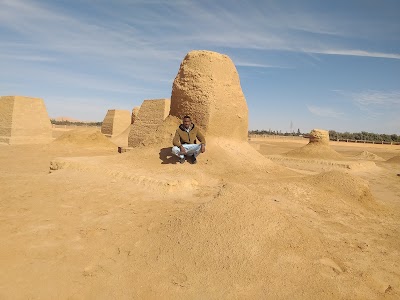Al-Aweinat Mountain (جبل العوينات)
Overview
Discovering Jebel Uweinat: A Natural Marvel Jebel Uweinat, also known as Al-Aweinat Mountain, is a breathtaking and remote peak nestled in the Wadi al Hayaa District of Libya. This majestic mountain holds a significant position at the tripoint where the borders of Libya, Egypt, and Sudan converge, making it a fascinating destination for travelers and adventurers alike. Rising dramatically from the surrounding arid desert, Jebel Uweinat stands as a stunning symbol of natural beauty and a testament to the Earth's geological history. Elevation and Geological Significance Reaching an impressive elevation of approximately 1,934 meters (6,345 feet) above sea level, Jebel Uweinat ranks among the tallest peaks in the region. Its formation spans millions of years, shaped by tectonic movements and volcanic activity that have created the rugged, rocky landscape we admire today. Predominantly composed of granite and other igneous rocks, the mountain showcases distinctive formations and intricate patterns, telling the story of its ancient origins. Pristine Wilderness and Unique Flora What sets Jebel Uweinat apart is its largely untouched environment, preserving its unspoiled character and making it a paradise for geologists and nature enthusiasts. The mountain is surrounded by vast stretches of desert, enhancing its allure and mystique. Despite the harsh conditions, rare vegetation such as Acacia trees and resilient desert shrubs can be found, clinging to life in this arid landscape. An Archaeological Treasure Trove Beyond its geological wonders, Jebel Uweinat is an archaeological gem. Ancient rock art sites scattered throughout the mountain provide invaluable insights into the lives of prehistoric peoples who once roamed the area. These rock carvings and paintings depict various scenes, including wildlife, hunting activities, and human figures, some dating back thousands of years, offering a glimpse into the region's rich history. Intriguing Cave Systems The mountain also boasts intricate cave systems, formed over millions of years through erosion and geological processes. These caves provide a cooler refuge from the scorching desert heat and are often home to unique and resilient forms of life. Exploring these hidden chambers offers a captivating glimpse into the unseen world beneath Jebel Uweinat. Challenges of Exploration Exploring Jebel Uweinat can be challenging due to its remote and inhospitable environment. However, those adventurous enough to embark on the journey are rewarded with breathtaking views, a rich tapestry of history, and a profound sense of awe. Ongoing efforts to study and preserve the mountain reflect a commitment to understanding its geological significance and protecting its delicate ecosystems. Nomadic Communities and Stewardship While human habitation around Jebel Uweinat is sparse, a few nomadic communities have adapted to the harsh desert conditions. With their deep knowledge of the land, these communities play a crucial role in the stewardship of the area, ensuring that the mountain's heritage is respected and preserved for future generations. Conclusion: A Landmark of Significance In summary, Jebel Uweinat stands as a remarkable natural landmark in the Wadi al Hayaa District of Libya, celebrated for its geological, archaeological, and ecological significance. Its formation, rich history, and challenging terrain offer a captivating experience for all who venture to encounter its wonders. Whether you are an adventurer, a history enthusiast, or a nature lover, Jebel Uweinat promises a journey filled with discovery and inspiration.








